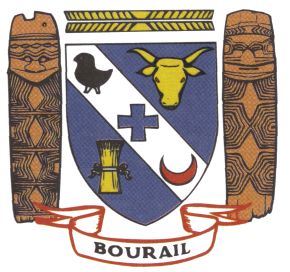Bourail: Difference between revisions
Jump to navigation
Jump to search
Knorrepoes (talk | contribs) (Created page with '{|width="100%" style="color:black; background-color:#ffffcc;" |width="15%"|50 px|left |width="70%" align="center" |'''Heraldry of the World<br/>Civic he…') |
Knorrepoes (talk | contribs) m (Text replace - "'''Origin/meaning:'''<br> " to "====Origin/meaning==== ") |
||
| Line 9: | Line 9: | ||
[[File:bourail.jpg|center]] | [[File:bourail.jpg|center]] | ||
====Origin/meaning==== | |||
The arms show a silver bend with three symbols : 1) a yellow-legged blackbird, a species which was imported in 1875 locally from the Molucans to fight locusts in the sugar cane plantations; 2) a blue cross, referring to the local New Zealand cemetery and 3) a crescent, as a symbol for the Arab presence in the municipality. | The arms show a silver bend with three symbols : 1) a yellow-legged blackbird, a species which was imported in 1875 locally from the Molucans to fight locusts in the sugar cane plantations; 2) a blue cross, referring to the local New Zealand cemetery and 3) a crescent, as a symbol for the Arab presence in the municipality. | ||
Revision as of 16:33, 8 December 2012
| Heraldry of the World Civic heraldry of New Caledonia |
BOURAIL
Origin/meaning
The arms show a silver bend with three symbols : 1) a yellow-legged blackbird, a species which was imported in 1875 locally from the Molucans to fight locusts in the sugar cane plantations; 2) a blue cross, referring to the local New Zealand cemetery and 3) a crescent, as a symbol for the Arab presence in the municipality.
The bull's head and the wheat-sheaf are symbols for the agricultural character of the municipality.
Beside the shield are two local Kanak wood carvings as a symbol for the Kanak culture.
Literature : Image and information obtained from the municipality

